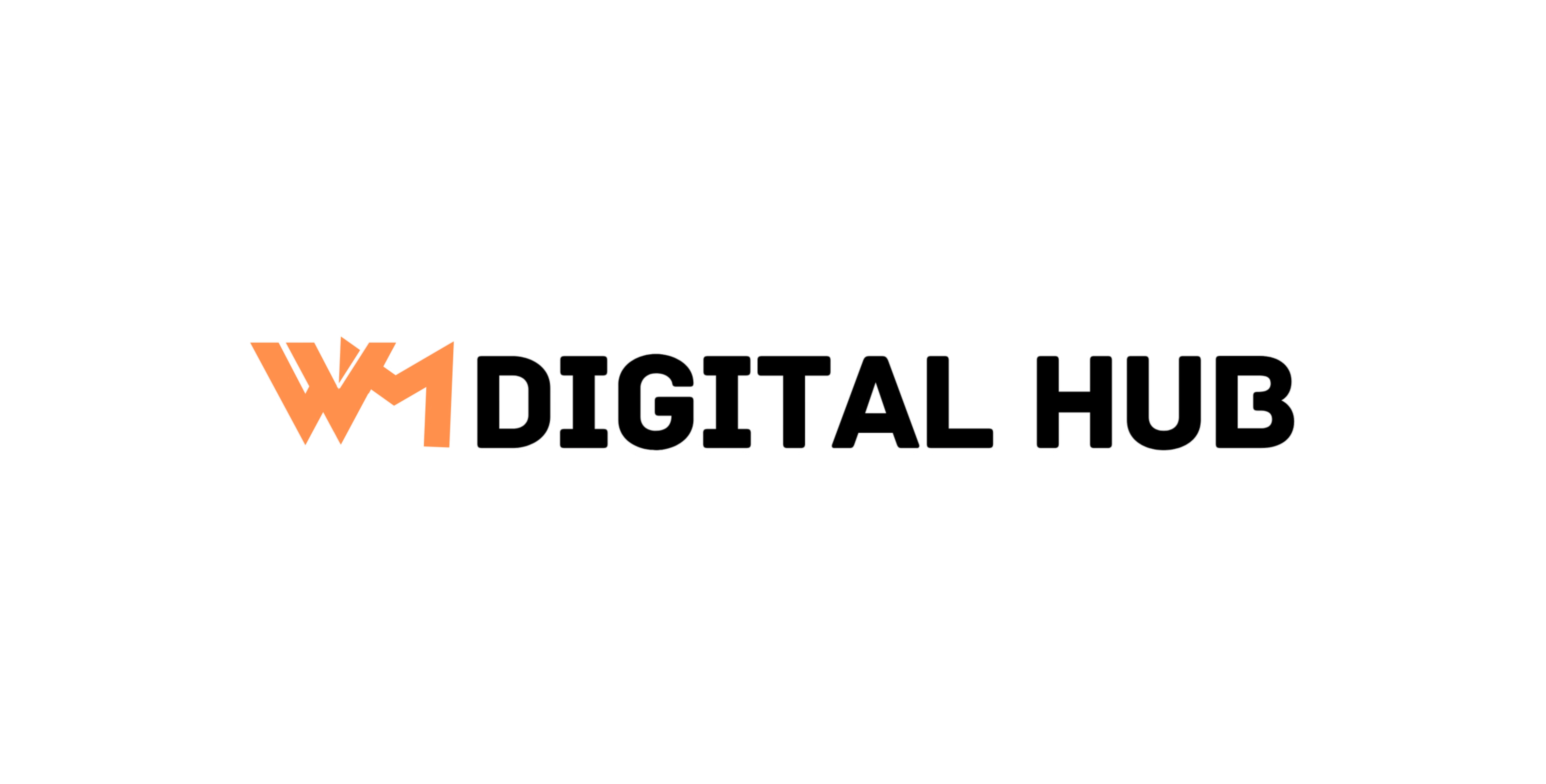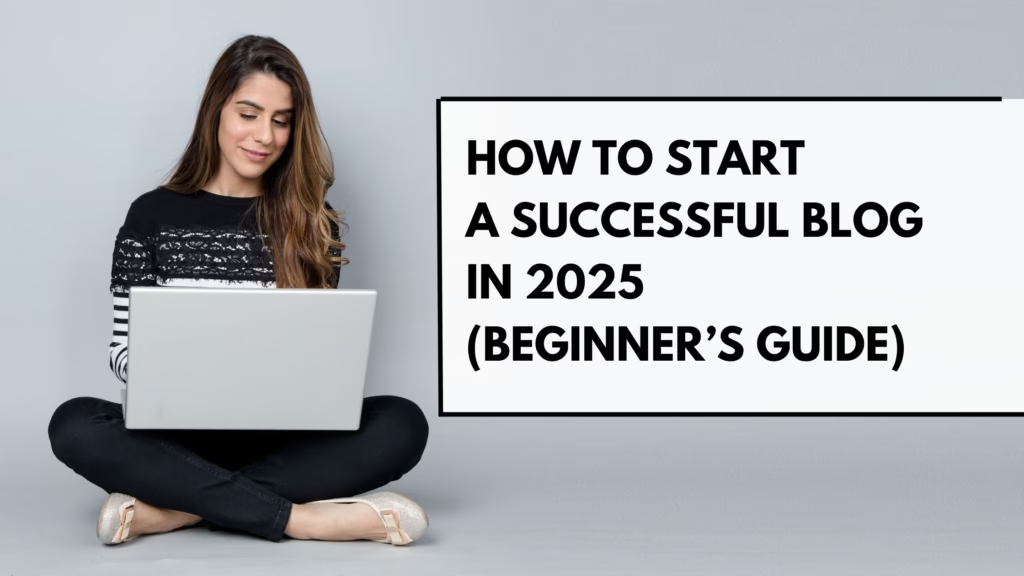Have you ever wondered how people share their stories, passions, and expertise with the world? The answer is simple: blogging. Starting a blog is like unlocking a digital stage where your ideas can shine, connect with audiences, and maybe even transform into a successful venture.
Take Sarah, for example. She started a food blog from her tiny kitchen, sharing her love for baking. Today, her blog attracts thousands of readers each month and even supports her financially. You, too, can turn your hobbies, knowledge, or unique perspective into a blog that resonates with others.
The beauty of blogging lies in its accessibility. You don’t need to be a tech genius or a professional writer to get started. Whether you’re looking to share life experiences, build an online business, or explore a new creative outlet, this guide will walk you through how to start a blog step by step.

Why Choose Blogging?
Blogging not only gives you a platform to express yourself, but it also opens doors to opportunities like building an audience, earning money, or creating a personal brand. It’s your digital diary, your professional portfolio, or even your online shop, depending on how you decide to use it.
What You’ll Learn in This Guide
We’ve made it simple for you. This comprehensive guide will teach you everything you need to know about starting a blog—from choosing the perfect niche and setting up your website to writing engaging posts and growing your audience.
By the end, you won’t just know how to start a blog but also how to make it successful, even if it’s your very first time.
Prepare to take action, step by step. It’s time to turn your passion into something impactful. Your ideas are worth sharing, and the world is waiting to hear them. Grab a notebook, jot down your thoughts, and let’s build something amazing together!
Next step? Stick around as we explore why choosing the right niche is the foundation of your blogging success.
Why Start a Blog?
What makes blogging so rewarding? It’s more than just writing words on a webpage; it’s a way to share your voice, connect with others, and open doors to opportunities you’ve never imagined.
Blogging has something for everyone. Whether you’re a professional looking to build your brand, a hobbyist wanting to share your passion, or a business owner aiming to connect with customers, having a blog can transform your goals into reality.
The Benefits of Blogging
- Creative Expression and Storytelling
Blogging is like having your own digital canvas. Whether you enjoy writing about personal experiences or teaching others a skill, your blog becomes a haven for creativity. - Building a Personal Brand
For professionals, creating a blog is a fantastic way to showcase your expertise. Imagine being a career coach with a blog full of insightful career advice. It instantly positions you as an authority in your field. - Income Potential
Blogging has become more than a passion project for many—it’s a career. Some bloggers earn passive income through ads, affiliate marketing, or sponsored content. - Sharing Your Knowledge and Helping Others
Blogs offer a unique way to help people around the world. If you’re great at baking, DIY crafts, or even coding, your tutorials and tips can offer real value to readers.
An Inspiring Example
Take the story of John. He was a tech enthusiast who shared his love for gadgets through a simple blog. Over time, his honest reviews and advice gained traction. Today, his blog not only supports his passion but also earns him a full-time income through partnerships with tech brands.
How Blogging Helps Different Audiences
- For Professionals: Blogging elevates your voice in a competitive market. Think of it as your public resume. Prospective employers, clients, or collaborators can see your skills upfront.
- For Hobbyists: Love gardening, crafting, or gaming? A blog allows you to share your experiences with a global audience, connect with like-minded people, and maybe even monetize your hobby.
- For Business Owners: Blogging is a cost-effective way to connect with customers. By providing useful content related to your products or services, you build trust and showcase your expertise.
Blogging isn’t just about writing; it’s about creating a space where you can inspire, inform, and grow. No matter your reason, a blog can be the perfect platform to achieve your dreams.
Next up? Narrowing down your blog’s purpose and finding the perfect niche.

Choosing Your Niche
When starting a blog, your chosen niche can make or break your blogging success. But what exactly is a niche? It’s the specific topic or area your blog will focus on. Picking the right one isn’t just important; it’s essential. Your niche largely decides who will read your blog, how much engagement you’ll get, and even your blog’s potential for earning income in the long run.
Why Is Choosing a Niche Important?
Imagine walking into a bookstore and seeing a section titled “Everything.” Overwhelming, right? That’s why you need a niche—to give your blog direction and make it easy for readers to know what to expect. A focused niche helps you connect with the right audience and stand out among millions of blogs.
Tips for Finding the Right Niche
Finding your perfect blog niche doesn’t have to be hard. Here are some steps to help you zero in on the right one for you.
- Follow Your Passion
Blogging takes time and effort, so picking a niche you genuinely enjoy makes it easier to stay consistent. Ask yourself, what excites you? Is it fitness, travel, or maybe cooking? Writing about something you’re passionate about can turn your blog into a long-term commitment rather than a short-lived hobby. - Leverage Your Expertise
What skills or knowledge do you already have? Readers often visit blogs to learn or solve a problem. If you’re an expert photographer, for instance, a blog offering tutorials and editing tips could attract a loyal audience. - Research Audience Demand
Passion and expertise are significant, but they need to align with what people are searching for. Use tools like Google Trends or keyword research platforms to see what topics are trending and have higher demand. For example, niches like personal finance, productivity, and tech reviews consistently perform well. - Evaluate the Competition
Some niches, like fashion or travel, are highly competitive. While you shouldn’t avoid these niches, figure out how you can offer something unique. Perhaps you can focus on sustainable fashion or budget travel tips to carve your space in a crowded market. - Align It with Your Goals
Why are you starting this blog? If making money or building a brand is important, consider niches with monetization potential. Topics like digital marketing or affiliate product reviews come with income opportunities.
Examples of Popular Blog Niches
If you’re unsure about which direction to take, here are some tried-and-tested niches that continue to perform well:
- Food and Recipes: Share your culinary skills, unique recipes, or food photography tips.
- Fitness and Wellness: A great choice if you’re into workouts, mental health, or lifestyle improvement.
- Personal Finance: Budgeting advice, investment tips, and ways to save money attract high readership.
- Parenting and Family Life: Helping parents with child-rearing advice or sharing relatable experiences can build a loyal audience.
- Travel Blogging: Whether it’s luxury getaways or backpacking trips, travel enthusiasts are always looking for fresh ideas.
How to Test Your Niche
Before committing, write a few test blog posts or brainstorm topic ideas for your chosen niche. If you can come up with ten or more engaging topics without much effort, you’re likely on the right track.
Remember, the best niche balances your passion, skillset, and audience interest. Take your time deciding, and once you’re confident, you’ll be ready for the next steps.
Coming up next? Setting up your blog and turning your chosen niche into reality!

Setting Up Your Blog
You’ve chosen your niche, and now it’s time to bring your blog to life. Don’t worry if this sounds technical! Setting up your blog is straightforward if you break it into manageable steps. Whether you’re a complete beginner or have some experience, this guide will simplify everything for you.
Step 1 – Choose Your Blogging Platform
Your blogging platform is where all the magic happens. It’s the software you use to create and manage your blog. Popular options include WordPress.org, Wix, and Squarespace, but the standout choice for serious bloggers is WordPress.org.
Why WordPress.org?
- Complete Control: It lets you fully customize your blog.
- Scalability: Whether it’s a personal blog or a business site, WordPress can grow with your needs.
- Plugins Galore: Add extra functionality with thousands of free and premium plugins.
For ultimate flexibility and professional features, WordPress.org is the top recommendation.
Also read : 10 Best Free Blogging Platforms for Beginners
Step 2 – Select a Domain Name
Your domain name is your blog’s unique address on the internet, like “www.TravelWithNia.com.” It should reflect your niche and be easy for readers to remember.
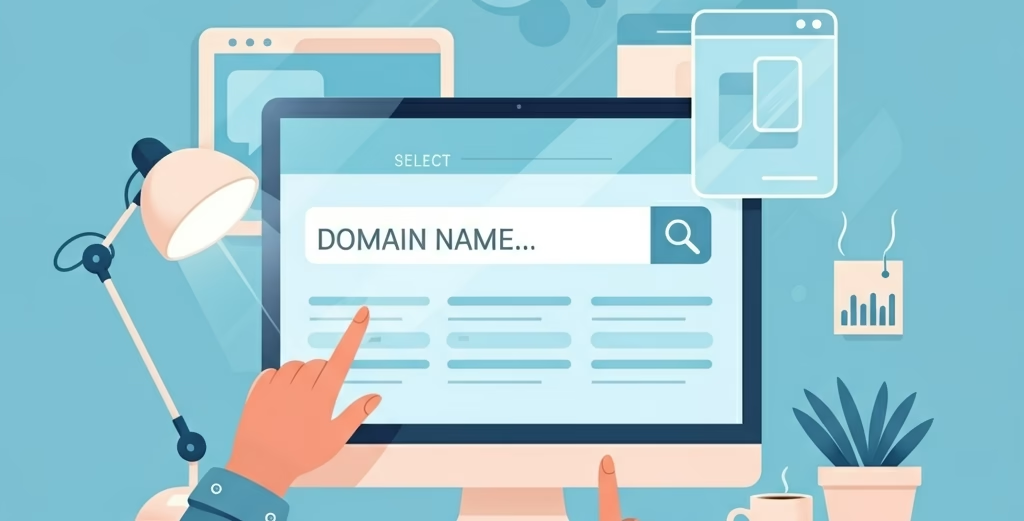
Tips for Choosing a Domain Name:
- Keep it short, simple, and relevant to your blog.
- Use keywords related to your niche, like “WellnessJourney” for a health blog.
- Avoid numbers, hyphens, and overly complicated terms.
- Use domain tools on platforms like Hostinger or Bluehost to check availability.
Pro Tip: If your ideal domain name isn’t available, try adding a creative twist, like “MyCulinaryDiary” instead of “CulinaryDiary.”
Step 3 – Choose a Reliable Web Hosting Provider
Web hosting gives your blog a place to live on the internet. Think of it like renting space for your website – just as a house needs land, your blog needs hosting to be accessible online.
A good web host stores your blog’s files, keeps it running smoothly, and ensures visitors can access it 24/7. Without hosting, your blog won’t be visible to anyone.
For beginners and professionals alike, services like Hostinger and Bluehost are trusted for their reliability, fast performance, and excellent support.
The best part? It doesn’t cost much to get started. With Hostinger, you can launch your blog for as low as $2–$3 per month – and if you use any of the links in this blog post, you’ll get up to 20% off, exclusively for my readers!
So, you don’t need to spend a lot to start your blogging journey professionally.
Why Choose Hostinger?
- Extremely affordable plans that are perfect for new bloggers.
- Fast website performance with 24/7 customer support.
- Includes free domain registration on premium plans.
Why Choose Bluehost?
- Beginner-friendly setup with a free domain for the first year.
- Recommended by WordPress itself, making it a trusted choice.
- 24/7 expert support to guide you at every step.
How to Purchase Domain and Hosting on Hostinger:
Setting up your blog with Hostinger is super simple. Here’s how you can do it step by step.
- Visit Hostinger.com:
Go to their website and click on the “Web Hosting” section. For beginners, the “Single Web Hosting” or “Premium Shared Hosting” plan is a great choice.
- Select Your Plan:
Compare features and pricing. The Premium Shared Hosting is recommended because it includes a free domain and email hosting.
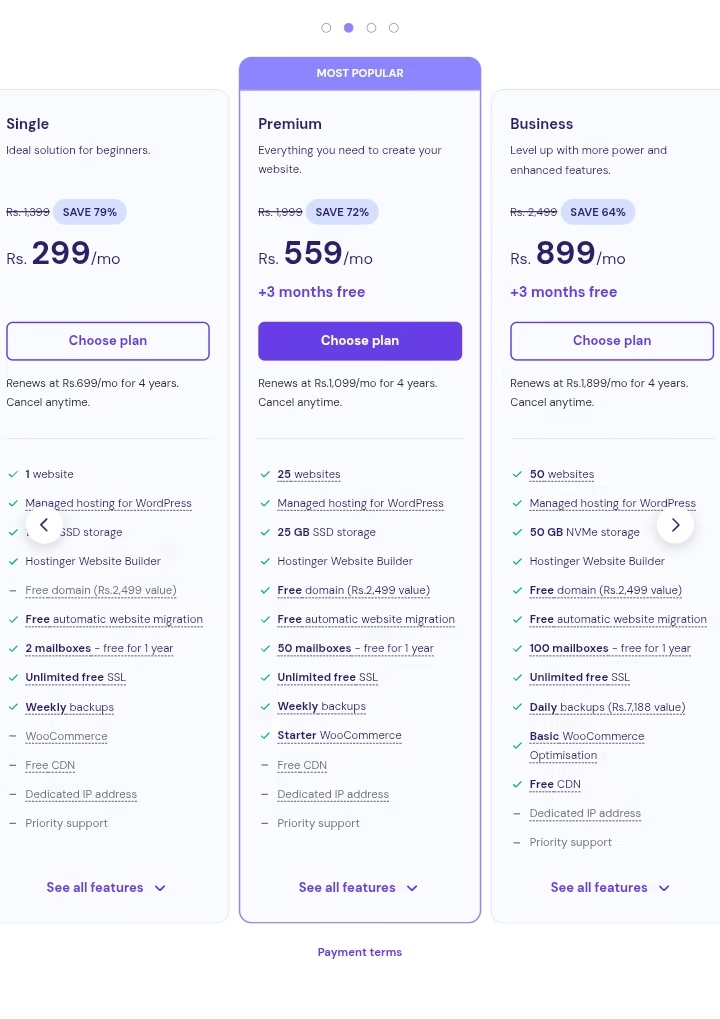
Once you’ve selected your hosting plan (Premium or Business), click on “Choose Plan.” Hostinger will take you to a summary page where your selected plan and pricing will be shown. Here you can:
Review your plan duration (12 months or more for free domain)
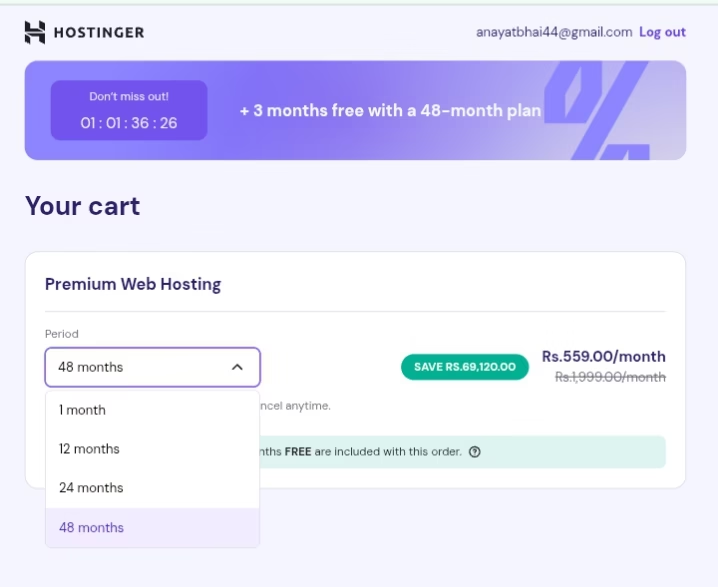
Confirm that the free domain offer is included
Click “Checkout Now” to proceed.
If you don’t have a Hostinger account yet, you’ll be asked to sign up using your email address, Google, or Facebook account.
3. Enter Payment Details:
Hostinger accepts multiple payment methods, like:
Credit/Debit Card
PayPal
Google Pay
UPI / Local Payment Options (depending on your country)
Simply choose your preferred method, enter the required details, and confirm
.
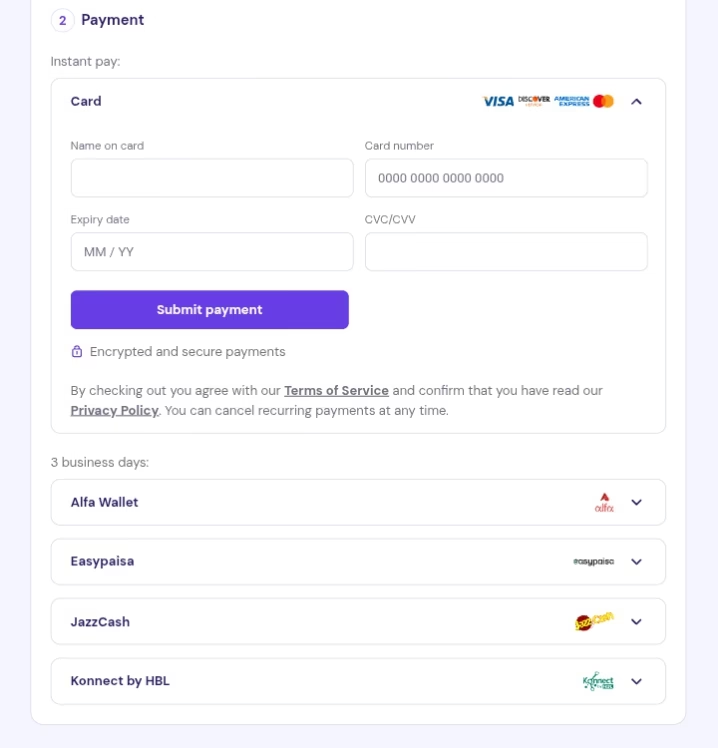
Register Your Domain Name:
After purchasing hosting, select the free domain offer included in the plan, choose your domain name, and complete the setup.

Set Up WordPress:
Hostinger includes a simple one-click WordPress installer. After purchasing, log in to your dashboard, find the WordPress option, and follow the prompts. Within minutes, your blog will be live.
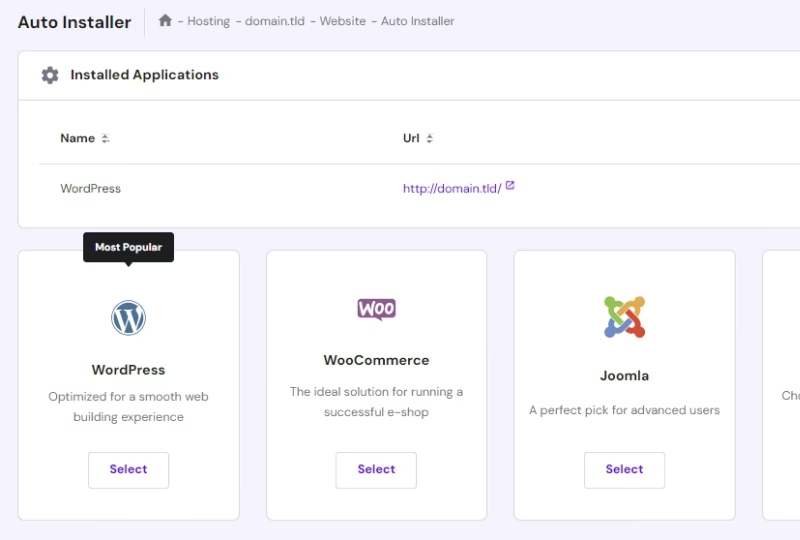
Using Bluehost? The steps are similar. Head to their site, select a hosting plan, register your domain, and follow the installation prompts for WordPress.
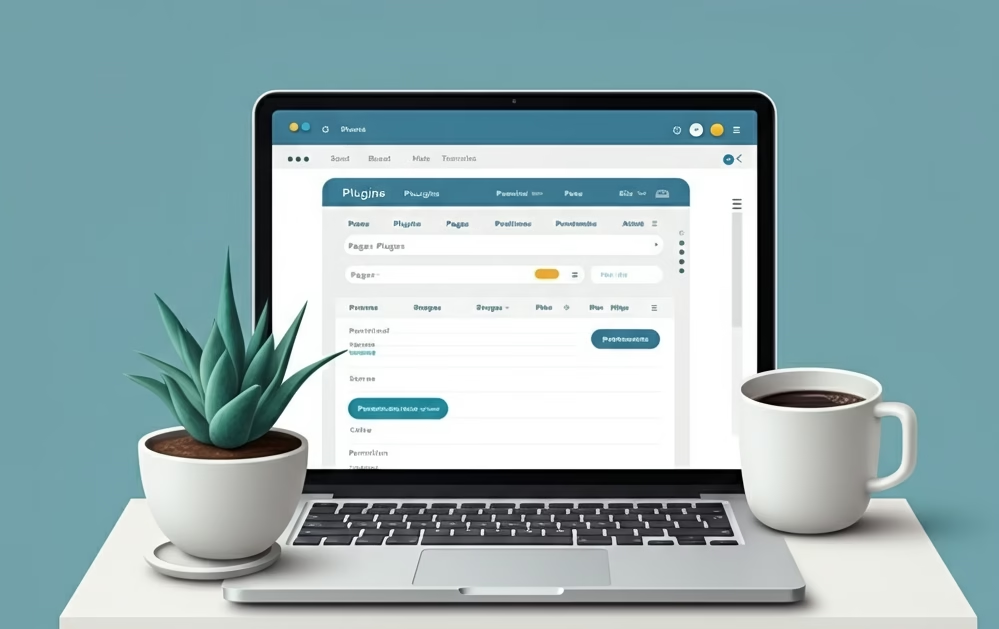
Essential Steps to Launch Your WordPress Blog
Launching a WordPress blog may seem like a large task, but breaking it into smaller, actionable steps makes the process much simpler. Here’s a comprehensive guide to help you set up and optimize your blog for success.
1. Essential Plugins
Plugins are essential tools that enhance your WordPress site’s functionality. They help with performance, security, and customization. Below are some highly-recommended plugins for every blogger:
- Yoast SEO
Optimize your blog’s content for search engines and improve its readability.
Yoast SEO Official Guide - Rank Math SEO
A robust SEO plugin offering advanced features for better on-page optimization.
Rank Math Official Guide - Akismet Anti-Spam
Keeps your blog free from spam comments.
Akismet Anti-Spam Official Guide - Jetpack
Combines security, performance, and analytics tools in one plugin.
Jetpack Official Guide - WP Super Cache/W3 Total Cache
Improves your blog’s loading speed through caching.
WP Super Cache Official Guide
W3 Total Cache Official Guide - Smush
Compresses and optimizes your images for faster loading times, without compromising quality.
Smush Official Guide - Elementor (Page Builder)
A drag-and-drop tool that allows you to create custom page layouts without coding.
Elementor Official Guide - UpdraftPlus
Simplifies the backup and restoration process to safeguard your blog’s data.
UpdraftPlus Official Guide
These plugins ensure your blog is optimized, efficient, and easy to manage.
2. Adding Plugins
Installing plugins is easy and enhances the functionality of your WordPress blog. Follow these steps to add plugins:
- Log in to the WordPress dashboard.
- Navigate to Plugins > Add New.
- Use the search bar to find a plugin (e.g., Rank Math).
- Click Install Now next to the desired plugin.
- After installation, click Activate to enable it.
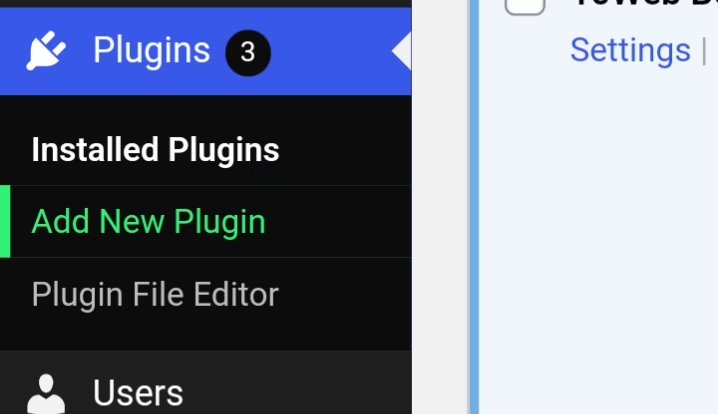
All installed plugins can be managed via the Plugins section in your dashboard.
3. Permalink Settings
Permalinks are the unique URLs assigned to your blog posts and pages. Configuring them correctly aids in both SEO and user experience.
Here’s how to set them up:
- Log in to your WordPress dashboard and go to Settings > Permalinks.
- Choose Post Name as your permalink structure (e.g., www.example.com/your-post-title).
- Save your changes.
By making URLs clean and descriptive, you make your content more accessible for users and search engines.
4. Basic WordPress Settings
Setting up your WordPress basics ensures that your blog is functional and user-friendly. Here are the essential settings to configure:
- Site Title & Tagline
- Go to Settings > General.
- Add a compelling Site Title and a brief Tagline reflecting your blog’s purpose.
- Time Zone
- Adjust the time zone under Settings > General according to where you’re located. This ensures accurate scheduling of posts.
- Comment Moderation
- Under Settings > Discussion, configure whether and how visitors can comment on your posts and set moderation preferences.
- Default Media Sizes
- Go to Settings > Media to define consistent image size dimensions for your posts.
- Homepage Settings
- Under Settings > Reading, choose whether your homepage should display your latest blog posts or a static welcome page.
These foundational settings will give your blog a polished and professional feel.
5. Essential Pages
Creating key pages is vital to structuring your blog and ensuring visitors have all the information they need. Below are the must-have pages for your WordPress blog, along with step-by-step instructions on how to create them:
How to Add Pages in WordPress
- Log in to the WordPress Dashboard:
- Use your admin credentials to access your blog’s backend.
- Navigate to the ‘Pages’ Section:
- On the left-hand menu, click on Pages > Add New.
- Enter a Title:
- At the top, add the page title, such as “Home,” “About,” “Contact,” or “Privacy Policy.”
- Add Content:
- Use the WordPress block editor (Gutenberg) to add text, images, and other elements. You can also use plugins like Elementor for advanced page design.
- Publish the Page:
- Once you’re satisfied with the content, click Publish to make it live on your blog.
- Organize Pages:
- To display these pages in a menu, go to Appearance > Menus, select your pages, and add them to your navigation bar.
Key Pages to Create
- Home Page
- Your site’s main attraction. Introduce your blog, display highlighted posts, and include a clear call-to-action (CTA).
- About Page
- Share your story and the purpose of your blog. This helps build trust and connection with your audience.
- Contact Page
- Provide a way for people to reach you. Use plugins like Contact Form 7 for an easy-to-build form. Mention your email and social media links.
- Privacy Policy Page
- Essential for legal compliance if you collect data from users. WordPress includes a default Privacy Policy template that you can customize.
- Additional Pages
- Depending on your blog’s focus, create pages such as Services, Portfolio, or FAQ to offer more information.
Adding these essential pages ensures your blog is professional, easy to use, and informative for visitors.
By following these steps, your WordPress blog will be ready to attract, engage, and grow an audience. Take your time to optimize each step, and you’ll set yourself up for blogging success!
Step 4 – Design Your Blog
With hosting and a domain in place, it’s time to design your blog. A visually appealing and easy-to-navigate blog keeps readers coming back.
How to Customize Your Blog:
- Log in to your WordPress dashboard.
- Go to “Appearance” > “Themes” and choose a theme. There are free and premium options depending on your style and niche.
- Customize your theme by adding your logo, images, and brand colors to reflect your blog’s personality.
Simplicity is key here. Aim for a clean layout that’s not cluttered by too many elements, ensuring your readers can focus on your content.
By now, you should have a live, functional blog that’s ready for your creativity to shine. All that’s left is writing your first amazing blog post.
Creating Your First Blog Post
Your blog is all set up, and now it’s time to take that exciting first step towards building your content library. Writing your first blog post may seem overwhelming, but with a little guidance, you’ll be ready to hit “publish” in no time.
Step 1 – Choose a Compelling Topic
The first step to creating an engaging blog post is deciding what to write about. Think of topics that are relevant to your niche and resonate with your audience.
Tips to Pick the Right Topic:
- Solve a Problem: People love posts that address challenges or answer questions. For example, if your blog is about nutrition, you could write “Easy Meal Prep Ideas for Beginners.”
- Share Your Journey: Personal experiences build trust and connection. Share a story, like “My First 30 Days as a New Blogger.”
- Stay Trendy: Use tools like Google Trends or AnswerThePublic to uncover trending topics.
Step 2 – Conduct Keyword Research
Keyword research ensures your blog post gets discovered by your target audience. By identifying the right keywords, you can write content that aligns with what people are searching for online.
Recommended Tools for Keyword Research:
- Google Keyword Planner: A free tool to discover popular search terms in your niche.
- Ubersuggest: Offers keyword ideas, search volume, and difficulty level for each term.
- SEMrush: A premium tool that provides in-depth insights into search terms, competitor analysis, and more.
How to Use These Tools:
- Open one of the tools, like Ubersuggest, and enter a broad term related to your topic (e.g., “healthy recipes”).
- Review the keyword suggestions it provides. Look for keywords with high search volume but low competition, such as “quick healthy breakfast ideas.”
- Incorporate these keywords naturally into your title, subheadings, and text. For example, if “How to start a blog” is your focus keyword, include it seamlessly throughout your post without overloading it.
Pro Tip: Use long-tail keywords, such as “easy guide to starting a personal blog,” to target specific queries.
Step 3 – Structure Your Blog Post
A well-organized blog post improves readability. Follow this simple structure:
- Title: Write a catchy and benefit-driven title. For example, “How to Start a Blog in 5 Easy Steps” sparks curiosity and brings clarity.
- Introduction: Hook your readers with a question, stat, or story. Outline what they’ll gain by reading further.
- Body: Break content into smaller sections with subheadings and bullet points. Make it easy to skim, especially for mobile readers.
- Visuals: Enhance your post with images, infographics, or videos.
- Call-to-Action (CTA): End with a clear action step, such as prompting users to comment, share, or subscribe.
Step 4 – Write an Engaging Introduction
Your introduction is your chance to catch the reader’s attention and convince them to keep reading.
Example:
“Ever wondered how to start a blog but felt intimidated by the process? You’re not alone! This step-by-step beginner-friendly guide will help you craft your first blog post like a pro.”
Keep the tone conversational and answer the “what’s in it for me?” question early on.
Step 5 – Use Visuals to Make Your Post Pop
Visuals are a great way to add life to your content. They help break up text and make complex ideas easier to understand.
Types of Visuals to Use:
- Images: Use free resources like Unsplash and Pexels for vibrant and high-quality pictures.
- Infographics: Summarize data and ideas visually. Tools like Canva make designing infographics simple.
- Screenshots: If your post explains technical steps, screenshots make it easier for readers to follow along.
Pro Tip: Optimize your visuals by compressing file sizes for faster page loading speed.
Step 6 – Keep SEO Best Practices in Mind
Search Engine Optimization (SEO) is crucial for driving traffic to your blog. Here’s how to do it effectively:
- Use Keywords Smartly: Naturally include phrases like “How to start a blog” in key areas (e.g., the title, introduction, and subheadings).
- Meta Descriptions: Write a concise summary of your blog (around 150-160 characters) to increase click-through rates.
- Internal and External Links: Link to relevant articles from your blog and credible external sources to provide added value.
- Focus on Readability: Use simple language, short sentences, and an active tone. Keep your content beginner-friendly..
Step 7 – Review, Format, and Publish
Before publishing, take some time to refine your post:
- Proofread: Check your post for grammar mistakes or typos. Even small errors can affect your credibility.
- Format: Use headings, bullet points, and short paragraphs to improve readability.
- Preview: Use your blogging platform’s preview option to ensure everything looks great.
When everything’s ready, hit “publish” and share your masterpiece with the world!
Building a Content Strategy
Once your first blog post is live, the next step is to focus on building a content strategy. Having a plan in place ensures you create and deliver consistent, high-quality content that keeps your audience coming back for more. It might sound like a lot, but with the right approach, this process can be straightforward and even fun!
Step 1 – Understand Your Audience
Before you start creating content, think about who you’re writing for. Understanding your audience helps you tailor your posts to their interests and needs.
How to Know Your Audience:
- Create a profile of your ideal reader. Ask questions like, “What’s their age, job, or biggest challenge in this niche?”
- Use tools like Google Analytics to gather insights on who is visiting your blog.
- Ask your audience directly through polls, surveys, or comments.
When you know your audience well, you can create content that truly resonates with them.
Step 2 – Brainstorm Content Ideas
Some days, your brain might feel like a blank slate. That’s when a robust list of content ideas comes in handy! Start brainstorming topics relevant to your niche and interesting to your readers.
Ways to Generate Blog Post Ideas:
- Keyword Research: Use tools like Google Keyword Planner or Ubersuggest to find what people are searching for in your blog’s niche.
- Competitor Analysis: Visit blogs in your niche to see what’s trending. For example, if your niche is fitness, see what topics other fitness bloggers are covering and add your unique spin.
- Reader Requests: Once your blog gains traction, pay attention to questions or comments from your readers. These can spark great content ideas.
- Seasonal or Evergreen Topics: Plan posts around holidays, events, or timeless topics that stay relevant year-round, such as “How to Set Goals for 2024” or “5 Productivity Tips for Everyone.”
Step 3 – Create a Content Calendar
Consistency plays a big role in blogging success. A content calendar helps you stay organized, manage deadlines, and maintain regular blogging habits.
How to Build a Content Calendar:
- Set a Posting Frequency: Decide how often you’ll publish new content based on your time and resources (e.g., weekly, biweekly, or monthly).
- Schedule Topics: Assign your brainstormed ideas to specific dates.
- Break It Down: Include tasks like research, writing, editing, and publishing to stay on top of each step.
You can use free tools like Google Sheets or Trello to plan and organize your calendar. Or, try specialized tools like CoSchedule for added functionality!
Step 4 – Focus on Quality Over Quantity
When it comes to blogging, it’s better to publish a few high-quality posts than churn out several mediocre ones. A well-researched, well-written post will always perform better than a rushed article.
Tips for High-Quality Content:
- Always provide value. Show your readers how to solve a problem, gain skills, or learn something new.
- Keep your writing clear and concise. Avoid unnecessary jargon or overly complex language.
- Proofread carefully or use a tool like Grammarly to ensure your content is error-free.
Remember, your readers will return if they trust your content is both useful and accurate.
Step 5 – Maintain Consistency
Consistency not only builds trust with your audience but also helps with SEO. Search engines favor actively maintained blogs with regular updates.
How to Stay Consistent:
- Batch your work. Write, edit, or schedule multiple posts at one time to stay ahead of your schedule.
- Keep it realistic. Don’t overcommit to a posting frequency you can’t maintain. Start small and scale up if needed.
- Automate where possible. Use scheduling tools like WordPress’ built-in scheduler or tools like Buffer to automatically publish posts at your chosen times.
Step 6 – Measure and Refine Your Strategy
Your content strategy isn’t set in stone. Regularly evaluate what’s working and tweak it based on those insights.
Check These Metrics:
- Traffic: Use tools like Google Analytics to track which posts are bringing in the most visitors.
- Engagement: Analyze comments, shares, and likes to identify topics your audience loves.
- SEO Performance: Use plugins like Yoast SEO or tools like SEMrush to check how your posts rank on search engines.
When something doesn’t perform well, don’t worry. Use it as a learning experience and shift your focus to strategies that produce better results.
By creating a solid content strategy, you’ll be able to maintain consistency, grow your audience, and ultimately achieve your blogging goals.
Promoting Your Blog
Your blog is live, you’ve crafted incredible content, and now it’s time to share it with the world! Promoting your blog is essential to drive traffic, build an audience, and keep your blog growing. Here’s how you can effectively promote your blog and get more eyes on your hard work.
Step 1 – Use Social Media to Share Your Posts
Social media is one of the best platforms for promoting your blog. With billions of active users, platforms like Instagram, Facebook, Twitter, and LinkedIn allow you to reach a massive audience.
Tips for Social Media Promotion:
- Choose the Right Platforms: Focus on networks where your audience is most active. For instance, LinkedIn is great for professional content, while Instagram works well for visual niches like travel or food.
- Post Consistently: Regular updates keep your followers engaged. Use a tool like Hootsuite or Buffer to schedule posts in advance.
- Engage With Your Audience: Reply to comments, participate in discussions, and build relationships with your followers.
- Leverage Groups: Join niche-specific communities on Facebook, Discord, or Reddit to share your expertise (without spamming).
Pro Tip: Use social media to tease your blog content. For example, share an eye-catching excerpt or create a short video summarizing your latest post.
Step 2 – Build an Email List
Email marketing is a powerful tool to connect with your audience on a deeper level. It lets you reach your readers directly without worrying about social media algorithms.
How to Get Started With Email Marketing:
- Set Up an Email List: Use platforms like Mailchimp or ConvertKit to start building your list.
- Create a Lead Magnet: Give visitors a reason to subscribe! Offer exclusive content like an eBook, checklist, or cheat sheet related to your niche. For example, “Subscribe for a Free Guide on How to Start a Blog.”
- Send Regular Updates: Keep your subscribers engaged by sending newsletters with new blog posts, updates, or tips.
Pro Tip: Segment your email list based on audience interests to create highly personalized emails.
Step 3 – Optimize for SEO (Search Engine Optimization)
SEO is a long-term strategy that helps your blog rank higher on search engines like Google. The higher your blog appears, the more organic traffic you’ll get.
SEO Tips for More Visibility:
- Use Keywords Effectively: Identify relevant phrases like “How to start a blog” and include them naturally in your titles, headings, and content.
- Write Meta Descriptions: Summarize each blog post in 150-160 characters to entice searchers to click on your link.
- Optimize Images: Compress images and use descriptive file names to improve loading speed and visibility.
- Build Backlinks: Reach out to sites in your niche for guest posts or collaborations to earn links back to your blog.
Pro Tip: Use tools like Google Analytics and SEMrush to monitor traffic and identify opportunities for improvement.
Step 4 – Collaborate With Others
Collaborations can be a game-changer in growing your blog’s audience. Partnering with others in your niche helps you tap into their audience while providing value to yours.
Ideas for Collaboration:
- Guest Posting: Write blog posts for other websites in exchange for a link back to your site. This not only promotes your blog but also improves your SEO.
- Interviews and Features: Host interviews or collaborate on joint projects with other bloggers or influencers in your niche.
- Shoutouts: Exchange mentions on social media platforms or blogs to cross-promote content.
Pro Tip: Approach collaborations with a spirit of mutual benefit. Focus on relationships rather than purely self-promotion.
Step 5 – Repurpose and Reuse Content
Maximize the reach of your hard work by repurposing blog posts into different formats for various platforms.
Ways to Repurpose Blog Content:
- Turn blog posts into engaging Instagram carousels or infographics.
- Create a YouTube video or a podcast episode based on your blog content.
- Share bite-sized tips from your post on Twitter or LinkedIn.
- Use older blog posts to create a downloadable resource, like a guide or checklist.
Pro Tip: Repurposed content can reach a new audience without requiring you to start from scratch.
Step 6 – Engage With Your Readers
An engaged audience is more likely to return to your blog and share your posts.
How to Keep Them Engaged:
- Reply to Comments: Respond to readers’ comments on your blog or social media platforms.
- Ask for Feedback: Encourage readers to share their thoughts or questions to make them feel heard.
- Host Giveaways: Organize contests with niche-related rewards to excite your readers.
Step 7 – Monitor Progress and Adjust
Promoting your blog is an ongoing process. Regularly review your marketing strategies to ensure what you’re doing is effective.
Metrics to Track:
- Traffic Sources: Find out where your visitors are coming from (e.g., social media, search engines, or referrals).
- Engagement: Check which posts are receiving the most comments, likes, or shares.
- Conversions: Track how many readers are signing up for your email list or taking action on your CTAs.
Use tools like Google Search Console and Ahrefs to gather insights and refine your approach.
By implementing these tips, you’ll steadily grow your blog’s audience and build a loyal reader base. Promotion takes time and effort, but it’s a rewarding part of your blogging journey.
Next Steps: Now that you know how to promote your blog, it’s time to focus on monetization! The next section will cover proven ways to earn money from your blog while staying true to your niche and audience. Stay tuned!
Monetizing Your Blog
Once you’ve built a solid foundation and attracted a steady flow of visitors, it’s time to monetize your blog and start earning from your hard work. There are several ways to make money from blogging, whether you’re looking for a side hustle or working toward full-time income. Here are the most popular methods to monetize your blog effectively:
1. Affiliate Marketing
Affiliate marketing is one of the easiest ways to get started. It involves promoting products or services through special affiliate links and earning a commission when someone makes a purchase using your link.
How to Get Started:
- Join Affiliate Programs: Sign up for programs like Amazon Associates, ShareASale, or CJ Affiliate.
- Select Relevant Products: Choose products or services that resonate with your audience and align with your niche. For instance, if you blog about fitness, promote workout gear or protein supplements.
- Add Links to Your Content: Insert affiliate links naturally within your blog posts, such as “Check out this budget-friendly hosting option on Hostinger” or “Get started with Bluehost’s amazing plans here.”
Pro Tip: Always disclose affiliate links to maintain transparency and build trust with your readers.
2. Sponsored Posts
Brands often collaborate with bloggers to create content that promotes their products or services. Sponsored posts can be an excellent way to monetize your blog while delivering value to your audience.
How to Attract Sponsored Opportunities:
- Build Your Traffic: Focus on growing your audience to make your blog appealing to potential sponsors.
- Create a Media Kit: Prepare a professional overview of your blog, including traffic stats, audience demographics, and past collaborations.
- Reach Out to Brands: Email brands or use platforms like AspireIQ or Influence.co to find campaigns that suit your niche.
Pro Tip: Always ensure sponsored content feels relevant and authentic to your audience.
3. Offer Products or Services
Selling your own products or services can provide a stable income source while utilizing your expertise to help others.
Popular Ideas for Blog-Based Products/Services:
- Ebooks & Courses: Share your knowledge by creating an ebook or online course. For example, a travel blogger might sell a guide on “Traveling Europe on a Budget.” Tools like Teachable or Gumroad make this process simple.
- Freelancing: Offer your skills, whether it’s writing, graphic design, or social media management, as a service to your readers.
- Physical Products: If you’re crafty, set up a store with handmade goods using platforms like Etsy.
Pro Tip: Highlight how your product or service solves a specific pain point for your audience to make it more appealing.
4. Earn Revenue From Ads
Displaying ads is a traditional yet effective way to make money from your blog. You earn revenue based on clicks or impressions when visitors interact with the ads.
Ways to Get Started With Ads:
- Google AdSense: Google’s advertising tool places relevant ads on your blog. It’s beginner-friendly and easy to set up.
- Ad Networks: Once your traffic grows, join premium ad networks like Mediavine or AdThrive for higher-paying opportunities.
- Direct Ad Sales: Work directly with companies to negotiate ad space on your site for banners or sponsored posts.
Pro Tip: Keep ads balanced so they don’t overwhelm your readers or slow down your blog’s loading speed.
5. Memberships and Exclusives
If you’ve built a loyal readership, offering exclusive content or memberships can be a great way to monetize your blog while creating a stronger community.
How It Works:
- Create a Members-Only Section on your blog with premium content like advanced guides, templates, or exclusive tips.
- Use platforms like Patreon or Buy Me a Coffee to offer subscription-based perks like early access to posts, Q&A sessions, or private online groups.
- Run live webinars or host workshops to connect directly with your audience and provide additional value.
Pro Tip: Use the free content on your blog to showcase your expertise and make readers curious about the premium content they can unlock through membership.
6. Sell Ad-Free Subscriptions
Some readers prefer an uninterrupted experience. Offer an option for your audience to subscribe to an ad-free version of your blog for a small monthly fee.
How to Set This Up:
- Use a platform like Substack to transition into ad-free subscriptions.
- Keep the cost affordable while highlighting benefits like faster-loading pages and an enhanced reading experience.
7. Partner With Brands for Long-Term Collaborations
While sponsored posts provide short-term income, developing long-term partnerships with brands can ensure consistent revenue over time.
How to Establish Partnerships:
- Identify brands that align with your vision and niche.
- Proactively propose collaboration ideas, like recurring promotions, product reviews, or event coverage.
Pro Tip: Long-term collaborations often lead to better revenue and stronger relationships compared to one-off sponsored posts.
Important Tips for Successful Monetization
- Stay Authentic: Only promote products, brands, or ideas you genuinely believe in. Your readers will value your honesty and return for trustworthy recommendations.
- Diversify Income Streams: Don’t rely on just one monetization method. A mix of strategies provides more opportunities and reduces risks.
- Focus on Your Audience: Your audience determines your success. Provide them with consistent value, and they’ll be more likely to support your monetization efforts.
Next Steps: Now that you know how to monetize your blog, the final piece of the puzzle is staying motivated and consistent while growing your blog into a sustainable venture. Stay tuned for the concluding section, where we’ll discuss long-term success strategies!
Staying Motivated and Growing Your Blog
Starting a blog is an exciting adventure, but maintaining and growing it over time requires dedication, consistency, and a lot of hard work. It’s natural to encounter challenges along the way, but with the right mindset and strategies, you can overcome hurdles and keep your passion for blogging alive. Here’s how to stay motivated and scale your blog for long-term success.
1. Set Clear and Achievable Goals
Goals act as your roadmap, giving you direction and purpose. Without them, it’s easy to feel lost or overwhelmed.
How to Set Effective Blogging Goals:
- Start Small: Break larger goals into smaller, manageable tasks. For instance, instead of “I want 10,000 readers,” focus on “I’ll write and promote one blog post per week.”
- Be Specific: Set measurable goals like “Increase email subscribers by 20% in 3 months” or “Publish 5 guest posts this quarter.”
- Track Progress: Use tools like Google Analytics or a simple checklist to track milestones.
Pro Tip: Celebrate small wins along the way to keep yourself motivated!
2. Learn from Analytics
Your blog’s analytics aren’t just numbers; they’re valuable insights into what’s working and what’s not. By understanding this data, you can refine your strategy and focus on areas that drive results.
What to Monitor:
- Traffic: Track which posts draw the most readers and replicate their success.
- Engagement: See which topics spark conversations through comments, shares, or likes.
- Conversions: Analyze how many readers sign up for your email list, buy your products, or take action on your CTAs.
Pro Tip: Use free tools like Google Search Console or Google Analytics to gather insights and guide your growth strategy.
3. Network With Other Bloggers
Blogging doesn’t have to be a solo effort. Building connections with fellow bloggers can open doors to new opportunities like collaborations, guest posts, or simply sharing ideas and advice.
Ways to Connect:
- Join blogging groups on Facebook, LinkedIn, or Discord to meet like-minded individuals.
- Attend webinars, workshops, or online conferences in your niche.
- Comment on other blogs and engage genuinely with their authors.
Pro Tip: Networking isn’t just about promoting yourself; it’s about building meaningful relationships based on trust and mutual support.
4. Stay Passionate About Your Niche
Your enthusiasm for your topic plays a huge role in keeping your blog alive and growing. If you’re genuinely interested in your niche, this energy will shine through in your writing and resonate with readers.
How to Keep the Passion Alive:
- Regularly revisit why you started your blog and the impact you want to create.
- Stay curious by learning more about your topic through books, courses, or industry news.
- Experiment with different types of content (videos, infographics, or podcasts) to keep things fresh.
Pro Tip: If you feel burnout creeping in, take a short break and come back recharged. It’s better to rest than to quit.
5. Adapt and Evolve
The digital space is constantly changing, and staying flexible is key to long-term success. What worked when you started might not be as effective a year later.
How to Stay Ahead:
- Pay attention to trends in your niche and blogging in general.
- Experiment with new formats, tools, or platforms to diversify your presence.
- Regularly audit your content to update outdated posts and improve older articles with fresh insights or better SEO.
Pro Tip: Keep learning! Follow industry leaders, take online courses, or attend training to develop new skills.
6. Don’t Be Afraid of Challenges
Every blogger faces setbacks, whether it’s writer’s block, slow traffic, or changing algorithms. The key is to view challenges as learning experiences rather than failures.
How to Overcome Tough Times:
- Give yourself grace and keep pushing forward, even if it means adjusting deadlines or taking things slower.
- Seek assistance from blogging communities or mentors who’ve faced similar issues.
- Remember that progress takes time, and consistency always pays off.
Pro Tip: Keep a “praise folder” with positive comments, compliments, or success milestones to remind yourself of how far you’ve come.
7. Stay Consistent, But Flexible
Consistency builds trust with your audience and keeps them coming back. However, life can get busy, so it’s okay to adjust your blogging schedule when needed.
Ways to Maintain Consistency:
- Create a realistic plan that aligns with your available time and energy.
- Batch-create content to stay ahead, especially during busier times.
- Focus on quality over quantity. It’s better to post less frequently but deliver value than to rush out mediocre content.
Pro Tip: Communicate with your readers if there’s a change in your schedule to maintain transparency and trust.
Final Thoughts
Blogging is a rewarding blend of creativity, strategy, and perseverance. The secret to long-term success lies in staying passionate, adapting to challenges, and consistently learning as you go. Remember, you don’t have to do everything perfectly from day one. Each step forward brings you closer to your goals, so enjoy the process!
Now that you know how to start a blog and grow it into a successful venture, it’s time to put these tips into action. Your blogging journey is uniquely yours, and with determination and effort, your blog can make a real impact. Good luck – you’ve got this!
